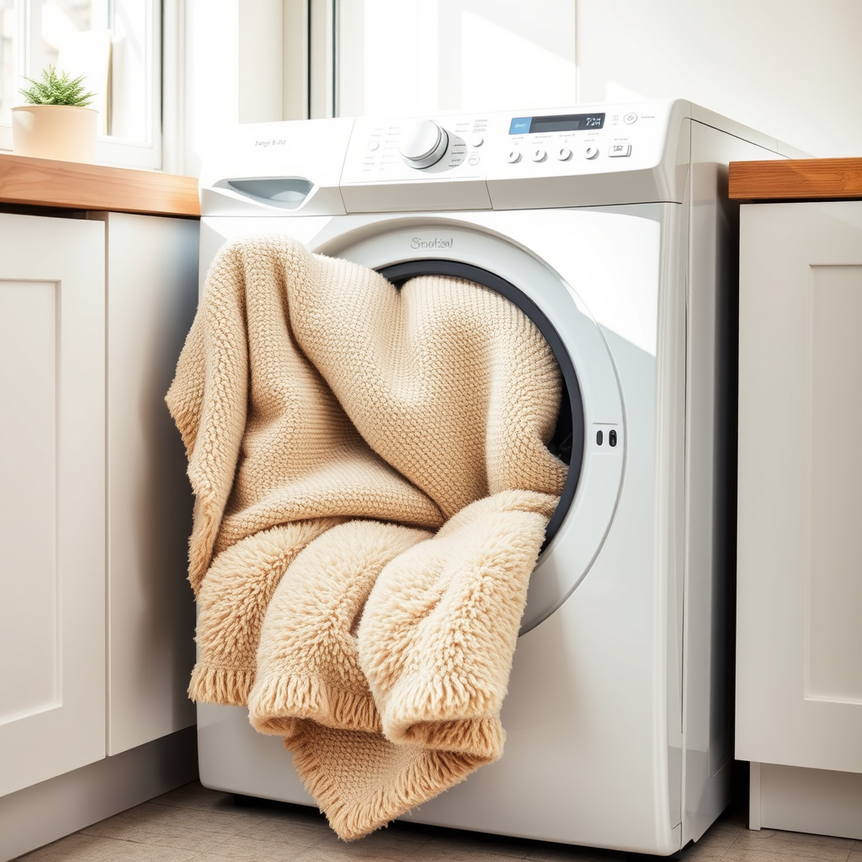Washing a king size blanket in a standard UK washing machine can seem like a daunting task due to its sheer size, but with the right knowledge and techniques, it’s perfectly achievable. At Rugstars UK, we understand the importance of quality home textiles for ultimate comfort and style. This comprehensive guide will walk you through everything from decoding care labels to mastering drying methods, ensuring your beloved king size blanket remains fresh, soft, and in excellent condition.
1. Understanding Your Blanket’s Needs: Decoding Care Labels & Material Types
Before you even think about putting your king size blanket into the machine, its care label is your ultimate guide. This small tag contains vital information mandated by law, dictating how to clean and maintain the fabric without causing damage. Ignoring it is the quickest route to a shrunken, misshapen, or otherwise ruined blanket.
Common Symbols to Look For:
-
Wash Tub Symbol:
Indicates washing method and maximum temperature (e.g., 30°C, 40°C). Dots inside signify temperature; one dot is cold, two is warm. A hand in the tub means hand wash only. A cross over the tub means do not wash.
-
Triangle Symbol:
Relates to bleaching. An empty triangle means bleach if needed, a triangle with two diagonal lines means non-chlorine bleach only, and a crossed-out triangle means do not bleach.
-
Square Symbol:
Pertains to drying. A circle inside means tumble dry, with dots for heat settings. A line inside means line dry. A crossed-out square means do not tumble dry.
-
Iron Symbol:
Indicates ironing instructions.
Key Considerations for Different Materials:
-
Wool (e.g., Merino, Lambswool):
Wool blankets, such as those made from delicate Merino or Lambswool, require the gentlest touch. Always look for a “wool cycle” on your machine, use cold water, and a specialised wool-friendly detergent. High heat can cause irreversible shrinkage and felting. Many wool blankets are best professionally cleaned or hand-washed.
-
Fleece (e.g., Polyester, Microfleece):
Fleece blankets are generally more robust and machine-washable. They often prefer a cool or warm wash on a gentle or synthetic cycle. Avoid very hot water and high heat in the dryer, as this can melt the fibres or cause pilling.
-
Cotton & Cotton Blends:
Cotton is a versatile and durable fibre. Most cotton blankets can be machine washed in warm or cold water on a regular cycle. Always check for blends, as synthetic additions might alter care instructions slightly.
-
Electric Blankets (Specific Warnings):
Crucially, most electric blankets are NOT machine washable. Washing them can damage the internal wiring, posing a serious safety risk. Always refer to your electric blanket’s specific care instructions. If it is machine washable, it will typically require a very gentle cycle, cold water, and air drying. When in doubt, seek professional cleaning advice or spot clean only.
2. The UK Machine Challenge: Fitting Your King Size Blanket Safely
The biggest hurdle for many UK households is whether a king size blanket will even fit into their standard UK washing machine. Overcrowding is a common issue and can lead to poor cleaning results and even damage to both your blanket and your appliance.
Typical UK Washing Machine Capacities:
- Standard Machines: Most UK washing machines have capacities ranging from 7kg to 10kg.
- Larger Models: Some newer or family-sized models offer capacities of 12kg or more, which are ideal for larger items.
Understanding King Size Blanket Dimensions and Weight:
A standard UK king size blanket typically measures around 230 x 260cm. However, their weight can vary significantly depending on the material and weave. For instance, a lightweight fleece blanket will weigh much less than a thick, multi-ply cotton or wool blanket. Our 2-Ply Soft King Size Blanket Bed Throw Comforter, for example, is designed to be substantial yet manageable.
Assessing if Your Blanket Will Fit Without Overcrowding:
The key is space. Once folded and placed inside the drum, your blanket should not fill more than three-quarters of the drum. There needs to be enough room for the water and detergent to circulate effectively and for the blanket to move freely, allowing for proper agitation and rinsing. If you have to forcefully stuff it in, it’s too big.
Why Overcrowding is a Problem:
- Poor Cleaning: Without adequate space, water and detergent cannot penetrate all fibres, leading to ineffective cleaning and lingering odours or stains.
- Machine Strain: An overloaded machine has to work harder, putting strain on the motor and potentially leading to breakdowns.
- Damage to Blanket: Overcrowding can cause excessive creasing, uneven washing, or even rips as the blanket is forced against the drum.
When a Professional Laundry Service Might Be Necessary:
If your king size blanket is particularly thick, heavy, or simply won’t fit comfortably into your home machine, don’t force it. A local laundrette often has larger capacity commercial machines (16kg+), which are perfect for bulky items. Alternatively, professional dry cleaning services are an excellent option, especially for delicate materials like certain wools or blankets with intricate embellishments.
3. Pre-Wash Essentials: Preparing for a Deep & Gentle Clean
A little preparation goes a long way in ensuring your king size blanket comes out of the wash looking and feeling its best.
Thorough Inspection for Damage:
Before washing, carefully inspect your blanket for any rips, loose threads, or embellishments that might become damaged or caught in the machine. Minor repairs like securing a loose stitch can prevent bigger problems during the wash cycle.
Spot Treating Stains Effectively:
Address any visible stains before the main wash. Apply a suitable stain remover directly to the stained area, following the product’s instructions. Gently blot (don’t rub) the stain with a clean cloth. Pre-treating increases the likelihood of complete stain removal, as machine washing alone might not be sufficient for stubborn marks.
Shaking Out Loose Debris, Pet Hair, or Crumbs:
Take your blanket outside or over a hard floor and give it a good shake. This will dislodge loose dirt, dust, pet hair, crumbs, and other debris, preventing them from clogging your washing machine filter or redepositing onto the fabric during the wash. A lint roller can also be effective for removing stubborn pet hair.
4. Mastering the Wash Cycle: Settings, Loading, and Detergent Selection
Once your blanket is prepped, it’s time to load the machine. Correct settings, loading, and detergent choice are crucial for optimal results.
Material-Specific Settings:
| Material | Water Temperature | Cycle Type | Spin Speed |
|---|---|---|---|
| Wool | Cold (30°C max) | Wool/Delicate | Minimal (600 RPM) |
| Fleece/Sherpa | Cold to Warm (30-40°C) | Delicate | Medium (800 RPM) |
| Cotton | Warm (40°C) | Gentle | Medium-High (1000 RPM) |
| Electric | Spot clean only | N/A | N/A |
-
Delicate/Wool Cycles for Natural Fibres:
For wool, cashmere, or other delicate natural fibres, select your machine’s “wool,” “hand wash,” or “delicate” cycle. These cycles use lower temperatures, reduced spin speeds, and gentler agitation to protect the fibres from shrinking or damage.
-
Gentle/Synthetics for Fleece and Blends:
For fleece, polyester, or cotton blends, a “gentle” or “synthetics” cycle with cool to warm water is usually appropriate. These cycles prevent excessive pilling and maintain the fabric’s soft texture.
-
Cold Water Washing for Energy Efficiency and Colour Preservation:
Whenever possible, opt for a cold water wash. It’s not only more energy-efficient, saving on your utility bills, but also helps preserve colours, prevent shrinkage, and is gentler on delicate fibres.
Proper Loading Techniques:
-
Folding and Loading to Ensure Balanced Distribution:
Don’t just stuff your blanket into the drum. Fold it neatly into a square or rectangle, then load it into the machine. This helps distribute the weight evenly, which is vital for preventing your machine from becoming unbalanced during the spin cycle. An unbalanced load can cause excessive vibrations and machine wear.
-
The “Three-Quarters Full” Rule for Optimal Washing:
As mentioned earlier, ensure the drum is no more than three-quarters full once the blanket is inside. This allows ample space for water and detergent to circulate and for the blanket to move freely, ensuring a thorough clean and rinse.
Detergent Selection:
-
Using Half the Usual Amount to Prevent Residue:
King size blankets absorb a lot of water and can be difficult to rinse thoroughly. Using half the recommended amount of detergent for a regular load is often sufficient and helps prevent detergent residue from building up on the fabric, which can make it feel stiff or sticky.
-
Specialised Wool Detergents for Wool Blankets:
For wool or other delicate fibres, always use a pH-neutral, wool-specific detergent. These detergents are formulated to protect protein-based fibres and prevent shrinking or damage.
-
Avoiding Fabric Softeners (Can Reduce Absorbency or Damage Fibres):
Generally, it’s best to avoid fabric softeners for most blankets. For fleece, softeners can reduce its natural absorbency and leave a residue that can diminish its softness over time. For natural fibres like wool, some softeners can damage the delicate fibres. If you desire extra softness, an extra rinse cycle or a cup of white vinegar in the rinse dispenser can often do the trick.
5. Effective Drying Strategies for Large Blankets: Air Dry vs. Tumble Dry
Drying a king size blanket requires patience and the right approach to avoid shrinkage, damage, or mildew.
Air Drying Methods:
Air drying is the gentlest and most energy-efficient method for drying large blankets.
-
Benefits of Air Drying (Gentle, Energy-Saving):
Air drying preserves fabric integrity, prevents heat damage and shrinkage, and significantly reduces your electricity consumption.
-
Tips for Drying Large Blankets Outdoors or Indoors (Drying Racks, Lines):
- Outdoors: If weather permits, hang your blanket over a sturdy washing line. Fold it evenly over the line to distribute the weight and prevent stretching. Use plenty of pegs to secure it.
- Indoors: If drying indoors, use a large, heavy-duty drying rack or multiple racks. Drape the blanket to allow maximum airflow. You can also hang it over a shower curtain rod or across several chairs, ensuring they are clean and won’t transfer colour.
-
Ensuring Even Drying to Prevent Mildew:
Periodically rotate and reposition the blanket to expose all areas to air. This prevents damp spots that can lead to mildew and an unpleasant musty smell. Ensure it is completely dry before folding and storing.
Tumble Drying with Caution:
If you must tumble dry, proceed with extreme caution.
-
Using the Lowest Heat Setting to Prevent Shrinkage and Damage:
Always use the lowest heat setting (or “air fluff” if available) and a delicate cycle. High heat is the primary cause of shrinkage and can damage synthetic fibres.
-
Adding Dryer Balls for Faster Drying and Fluffing:
Incorporate a few dryer balls (wool or plastic) into the drum. These help separate the fabric, allowing hot air to circulate more effectively, speeding up drying time, reducing static, and helping to fluff the blanket.
-
Checking Frequently and Repositioning the Blanket:
King size blankets can clump up in the dryer, leading to uneven drying. Pause the dryer every 15-20 minutes to shake out the blanket and reposition it, ensuring all parts dry evenly. Remove the blanket as soon as it’s dry to prevent over-drying and static.
6. Maintaining Freshness & Extending Life: Smart Care for Your King Size Blanket
Regular, smart care can significantly extend the life and freshness of your king size blanket.
Washing Frequency Guidelines:
-
For blankets in direct contact with skin (2-4 weeks):
If your blanket is used as a primary bed covering or directly against your skin every night, washing it every 2-4 weeks is advisable to remove skin cells, sweat, and allergens.
-
For decorative throws and comforters (2-3 months):
For blankets used more decoratively or as an extra layer not in direct contact with skin, washing every 2-3 months should suffice, unless a spill or stain occurs.
Regular Airing and Spot Cleaning Between Washes:
Between full washes, air your blanket outdoors on a fresh, breezy day (avoid direct harsh sunlight for delicate fabrics) or hang it by an open window. This helps to refresh the fibres and dissipate any minor odours. Promptly spot clean any small spills or marks to prevent them from setting.
Proper Storage Techniques to Keep Blankets Fresh:
When storing your blanket for an extended period, ensure it is completely clean and dry. Store it in a breathable cotton bag or a linen cupboard, rather than plastic, which can trap moisture and lead to mildew. Keep it away from direct sunlight and extreme temperatures.
7. Solving Common Washing Problems: When Your Blanket Doesn’t Cooperate
Even with the best intentions, problems can arise. Here’s how to troubleshoot common issues when washing large blankets.
Shrinkage:
-
Causes:
Typically caused by washing in too hot water or tumble drying on too high a heat setting, especially for natural fibres like wool or cotton.
-
Prevention Tips:
Always adhere to the care label, opt for cold water washing, and air dry or use the lowest heat setting on your tumble dryer.
Stiffness/Roughness:
-
Causes:
Often due to detergent residue from using too much detergent or insufficient rinsing, or hard water mineral buildup.
-
Remedies for Restoring Softness:
Re-wash the blanket using less detergent, or run an extra rinse cycle. Adding half a cup of white vinegar to the fabric softener dispenser during the rinse can also help break down mineral deposits and detergent residue, leaving your blanket feeling softer.
Won’t Fit in Machine:
-
Alternative Solutions (Laundrette, Hand Washing):
If your king size blanket simply won’t fit into your home machine without overcrowding, consider using a high-capacity machine at a local laundrette. For very delicate items that can’t be tumble dried, hand washing in a clean bathtub is another option, though it requires significant effort for rinsing and wringing.
Dealing with Lingering Odours or Detergent Residue:
If odours persist after washing, try adding half a cup of baking soda directly to the wash drum along with your detergent. For residue, an extra rinse cycle or the white vinegar trick (as above) can be very effective. Ensure the blanket is thoroughly dried, as dampness can lead to musty smells.
Final Thoughts: Keeping Your King Size Blanket Looking Like New
Properly caring for your king size blanket extends its life, maintains its softness, and ensures you continue enjoying that luxurious comfort for years to come. Remember these key points:
- Always check the care label first
- Never overload your UK washing machine
- Use cold water for most materials, especially wool
- Use less detergent than you think you need
- Air drying is preferable for most high-quality blankets
By following these guidelines, your king size blanket, like our 2-Ply Soft King Size Blanket Bed Throw Comforter, will remain a cherished part of your home’s comfort ecosystem through many British winters to come.
Have questions about caring for your specific blanket? Share your experiences in the comments below – our team of home textile experts is ready to help!
Frequently Asked Questions
- Q1: How often should I wash a king size blanket that I use every night?
For a king size blanket used nightly and in direct contact with your skin, it’s recommended to wash it every 2-4 weeks to maintain hygiene and freshness. For more details, refer to Section 6. - Q2: Can I wash a king size wool blanket in a standard UK washing machine?
It depends on your machine’s capacity and the blanket’s specific care label. If your machine has a “wool” or “delicate” cycle and the blanket fits comfortably without overcrowding (typically 10kg+ capacity for larger wool blankets), it might be possible. Always use cold water and a specialised wool detergent. For heavy or very delicate wool blankets, a professional cleaner or laundrette with larger machines is often the safest choice. See Section 1 and Section 2 for more information. - Q3: My king size blanket feels stiff after washing; what can I do?
Stiffness is often caused by detergent residue or hard water. Try re-washing the blanket using half the usual amount of detergent, or run an extra rinse cycle. Adding half a cup of white vinegar to the fabric softener dispenser during the rinse can also help soften the fibres and remove residue. More troubleshooting tips can be found in Section 7. - Q4: Is it better to air dry or tumble dry a king size blanket?
Air drying is generally better for king size blankets. It’s gentler on fibres, prevents shrinkage and heat damage, and is more energy-efficient. If you must tumble dry, use the lowest heat setting and dryer balls, and check frequently to reposition the blanket. Section 5 provides detailed drying strategies. - Q5: What are the main energy-saving tips when washing large blankets in the UK?
To save energy when washing large blankets in the UK:
1. Use cold water: Whenever possible, wash with cold water, as heating water consumes the most energy.
2. Ensure full, but not overcrowded, loads: Wash only when you have enough items to fill the machine properly, but don’t overstuff it, which makes the machine less efficient.
3. Opt for air drying: Air dry your blanket outdoors or indoors on racks instead of using a tumble dryer, which is a significant energy consumer.
4. Use lower spin speeds: While a higher spin extracts more water, which saves drying time, lower spin speeds use less electricity during the wash cycle itself and are gentler on the fabric.



